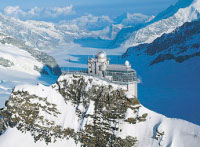- Home
- Science
- Research Groups
- Research Topics
- Annual Report
- Education
- Agenda
- Public & Media

- Contact Us
de Géophysique (Bât. B5c)
Quartier Agora
Allée du 6 août, 19C
B-4000 Liège 1 (Sart-Tilman)
Belgique
Tel.: 04.366.9779
Fax: 04.366.9729
Research Topics
Atmosphere

The Earth atmosphere is divided into several layers, characterized by their temperature and their composition. The closest layer relative to the ground is called the troposphere. This is where most of the meteorological phenomena take place. The layer located just above the troposphere is called the stratosphere. It ranges from 12 to 50 km and comprises the ozone layer. Researchers from the InfraRed Group of Atmospheric and Solar Physics (GIRPAS) actively contribute to the study these first two layers of the Earth atmosphere, taking advantage of a several decades long expertise. They analyze observations acquired from spectrometers installed at the Jungfraujoch station (Swiss Alps, altitude 3580 m). For example, these studies are crucial to characterize the increase of green house effect gas which modify the Earth climate and to survey the evolution of the ozone layer and of the gases threatening it.
Above the stratosphere is the mesosphere. This is the layer where dust and small meteorites burn as a result of frictions with the atmosphere, giving rise to the so-called shooting stars. Finally, the highest layer of the atmosphere is the thermosphere. It reaches up to several thousand of kilometers and fades gradually into space. The thermosphere is the region at the base of which northern and southern auroras. The auroras are studied by the researchers of the Laboratory for Planetary and Atmospheric Physics (LPAP), notably with measurements from the NASA's IMAGE spacecraft. These studies provide us with valuable information on the high atmosphere as well as on the Earth magnetosphere.



 Version française
Version française